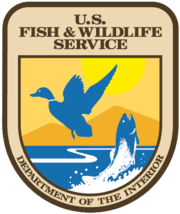Difference between revisions of "United States Fish and Wildlife Service (USFWS)"
(→Mission) |
(→Organizational Structure) |
||
| Line 18: | Line 18: | ||
==Organizational Structure== | ==Organizational Structure== | ||
| + | |||
| + | The USFWS agency executive is the director. The director is nominated by the President of the United States and then must be approved by the US Senate. Eight regional directors report to the agency director.<ref>Reference text https://fws.gov/offices/org-chart.html </ref> | ||
| + | |||
| + | Major sub-units of the USFWS include: | ||
| + | * [[National Wildlife Refuge System]] | ||
| + | * [[Division of Migratory Bird Management]] | ||
| + | * [[National Fish Hatchery System]] | ||
| + | * [[Endangered Species Program]] | ||
| + | * [[Internal Affairs Program]] | ||
| + | * [[National Conservation Training Program]] | ||
| + | * [[USFWS Office of Law Enforcement]] | ||
==Central Coast Context== | ==Central Coast Context== | ||
Revision as of 12:26, 4 March 2021
A organizational summary by the ENVS 560/L Watershed Systems class at CSUMB.
This page is an introduction to the United States Fish and Wildlife Service (USFWS) with specific emphasis on the Central Coast of California.

Contents
Overview
The United States Fish and Wildlife Service (USFWS) is a United States federal scientific agency within the US Department of the Interior (DOI). USFWS carries out a variety of duties that monitor, manage, and protect the nation's fish, wildlife, and natural habitats. In the California Central Coast Region, USFWS plays a large role in environmental management and regulation in conjunction with many cooperating institutions such as California Department of Fish and Wildlife (CDFW), California Invasive Plant Council, UC Santa Cruz, CalPoly SLO, and CSUMB.[1]
Mission
USFWS's service mission is "working with others to conserve, protect, and enhance fish, wildlife, plants and their habitats for the continuing benefit of the American people."[2] Their goal is to conserve natural ecosystems and resources for future generations through objective science-based management. USFWS has six major priorities: National Wildlife Refuge System, landscape conservation, migratory birds, threatened and endangered species, National Fish Habitat Action Plan, and connecting people with nature.[2]
Legal Status / Authority
Governance
Organizational Structure
The USFWS agency executive is the director. The director is nominated by the President of the United States and then must be approved by the US Senate. Eight regional directors report to the agency director.[3]
Major sub-units of the USFWS include:
- National Wildlife Refuge System
- Division of Migratory Bird Management
- National Fish Hatchery System
- Endangered Species Program
- Internal Affairs Program
- National Conservation Training Program
- USFWS Office of Law Enforcement
Central Coast Context
- Carmel River Floodplain Restoration and Environmental Enhancement (Carmel River FREE) Project
- Fort Ord Habitat Conservation Plan (HCP)
- Desalination in California's Central Coast Region
- California Tiger Salamander in California's Central Coast Region
Related links
References
- ↑ Reference text http://www.cesu.psu.edu/unit_portals/CALI_portal.htm
- ↑ 2.0 2.1 USFWS Fundamentals
- ↑ Reference text https://fws.gov/offices/org-chart.html
Disclaimer
This page may contain student work completed as part of assigned coursework. It may not be accurate. It does not necessary reflect the opinion or policy of CSUMB, its staff, or students.